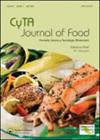Characterization of diamine oxidase-based biosensors for biogenic amines detection assembled onto functionalized SiO₂ substrates using aliphatic and aromatic di-aldehydes as crosslinkers
IF 1.7
4区 农林科学
引用次数: 0
Abstract
Development of two biosensors to detect biogenic amines was carried out using immobilized diamine oxidase from Pisum sativum on 3-APTMS-functionalized SiO2 substrates with either glutaraldehyde or terephthalaldehyde as crosslinkers. The assembly process was validated by FT-IR, SEM-EDX, and AFM. Biosensor responses to biogenic amines were c.a. 3-fold lower compared to the free enzyme kinetics as assessed by UV/VIS spectrophotometry. The calculated initial velocities (ΔAbs·min-1) for glutaraldehyde and terephthalaldehyde biosensors in the given order were (3.2 ± 0.68) × 10–2, (0.48 ± 0.09) × 10–2 for putrescine; (4.6 ± 1.2) × 10–2, (0.35 ± 0.47) × 10–2 for cadaverine; (5.8 ± 2.4) × 10–3, (19.0 ± 155) × 10–3 for spermidine, and (3.0 ± 2.0) × 10–4, (0.0 ± 7) × 10–4for histamine. The 2-way t-tests indicated that the crosslinker type affected the catalytic activity of immobilized diamine oxidase as the responses of glutaraldehyde biosensors to putrescine and cadaverine were significantly higher than those of the terephthalaldehyde. Molecular Docking simulations showed that glutaraldehyde has a stronger affinity for DAO’s lysine and arginine residues while terephthalaldehyde to phenylalanine.基于二胺氧化酶的生物胺检测传感器的表征,该传感器使用脂肪和芳香二醛作为交联剂组装在功能化的二氧化硅底物上
以3- aptms功能化的SiO2为底物,以戊二醛或对苯二甲酸为交联剂,固定化油菜二胺氧化酶,开发了两种检测生物胺的生物传感器。通过FT-IR, SEM-EDX和AFM验证了装配过程。通过紫外/可见分光光度法评估,生物传感器对生物胺的响应比自由酶动力学低约3倍。戊二醛和对苯二醛生物传感器在给定顺序下的计算初速(ΔAbs·min-1)为(3.2±0.68)× 10-2,腐胺为(0.48±0.09)× 10-2;尸胺为(4.6±1.2)× 10-2,(0.35±0.47)× 10-2;亚精胺为(5.8±2.4)× 10-3,(19.0±155)× 10-3,组胺为(3.0±2.0)× 10-4,(0.0±7)× 10-4。双向t检验表明,戊二醛生物传感器对腐胺和尸胺的反应显著高于对苯二醛,交联剂类型影响固定化二胺氧化酶的催化活性。分子对接模拟表明,戊二醛对DAO的赖氨酸和精氨酸残基具有更强的亲和力,而对苯二甲酸对苯丙氨酸残基具有更强的亲和力。
本文章由计算机程序翻译,如有差异,请以英文原文为准。
求助全文
约1分钟内获得全文
求助全文
来源期刊

Cyta-Journal of Food
FOOD SCIENCE & TECHNOLOGY-
CiteScore
4.40
自引率
0.00%
发文量
37
期刊介绍:
CyTA – Journal of Food is an Open Access journal that publishes original peer-reviewed research papers dealing with a wide range of subjects which are essential to the food scientist and technologist. Topics include: chemical analysis of food; additives and toxins in food; sensory, nutritional and physiological aspects of food; food microbiology and biotechnology; changes during the processing and storage of foods; effect of the use of agrochemicals in foods; quality control in food; and food engineering and technology.
 求助内容:
求助内容: 应助结果提醒方式:
应助结果提醒方式:


